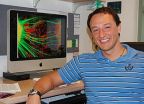(Press-News.org) Changes to China's drink driving laws are catching the community off guard with more than 70 per cent of people unaware of the blood alcohol limits that could see them face criminal charges, according to new Queensland University of Technology (QUT) research conducted in two Chinese cities.
QUT's Centre for Accident Research & Road Safety - Queensland (CARRS-Q) has partnered with organisations in China to promote road safety and reduce fatalities and injuries, as alcohol-related driving offences are being brought into sharper focus because of the country's rapid motorisation and entrenched alcohol culture.
CARRS-Q doctoral student Keqin Jia, who grew up in China and is now an Australian citizen, said alcohol was a major contributor to road crashes in China and in May 2011 the government amended legislation to criminalise offences against the higher of its two legal blood alcohol concentration limits for drivers.
"The amendments mean a driver caught with a blood alcohol level greater than 0.08 per cent is charged with driving while intoxicated, translated as "drunk driving", which is now a criminal offence," he said.
"Drivers with a blood alcohol level greater than 0.02 per cent and up to 0.08 per cent are charged with driving under the influence, translated as "drink driving", as before."
Mr Jia said since the new regulations were introduced there had been a drop in alcohol-related crashes, but there was concern around the limited awareness of the new limits and how that might be contributing to offending rates.
"What our studies found is that general drivers and convicted drunk drivers showed low levels of knowledge about the legal limits for drink driving and drunk driving offences," he said.
"Only 20 to 30 per cent of drivers nominated the correct legal limits for drink and drunk driving and convicted drunk drivers were only slightly more aware with between 20 and 40 per cent knowing the limits, despite having been prosecuted for their offence."
Mr Jia said one of the challenges for China was the lack of definition of what constituted a standard drink.
"The problem in China, compared to Australia, is that they have a wide availability of alcohol with a variety of alcohol concentrations, so it is difficult to define a standard drink.
"In Australia, road safety campaigners have been pushing for drinks to display labels advising of how many standard drinks are in a bottle, but there is nothing similar in China.
"Therefore there is very limited knowledge of the amount of alcohol that can be consumed while staying under the legal limit to drive.
"Our studies found that less than 10 per cent of drivers and convicted drunk drivers could say how many drinks they could consume and stay under the legal limit to drive.
"For beer and spirits, the results were even lower with only 2 per cent of convicted drunk drivers able to determine how many drinks were too many drinks to drive."
CARRS-Q is one of the leading road safety centres in Australia and is a vital player in the international pursuit of road safety.
Senior academic Dr Mark King said CARRS-Q was committed to helping build research capacity in rapidly motorised countries including China.
"Ninety per cent of road fatalities occur in low and middle income countries and CARRS-Q is committed to building capacity in these countries in the areas of research and intervention," Dr King said.
"This involvement includes funding PhD research into alcohol-related offences in China, as well as supporting research fellowships which have seen QUT researchers work and live in the country.
"QUT will continue to work with countries like China and support their research and intervention efforts aimed at addressing the enormous human, economic and social costs resulting from road crashes."
INFORMATION:
Other academics who have contributed to this research include Dr Judy Fleiter and Professor Mary Sheehan.
Mr Jia's research has been published in conference proceedings and journal articles are forthcoming or under review.
Jia, K., Fleiter, J., King, M., Sheehan, M., Ma, W. and Zhang, J. (Forthcoming). Knowledge and behaviours of drunk driving offenders in Guangzhou, China. International Journal of Alcohol & Drug Research.
Jia, K., King, M., Sheehan, M., Fleiter, J., Ma, W., Lei, J. and Zhang, J. (2013). Baseline study of alcohol dependence among general drivers and drink drivers in Guangzhou, China. Proceedings of RSRPE2013, Road Safety Research, Policing and Education Conference, 28-30 August 2013, Brisbane, Australia.
Jia, K., Fleiter, J.J., King, M.J., Sheehan, M., Dunne, M. and Ma, W. (2013). Reducing alcohol-related driving on China's roads: Traffic police officers' perceptions and practice. Proceedings of RS4C 2013 (Road Safety on Four Continents, 16th International Conference), Beijing, China, 15-17 May 2013.
A new climate change modeling tool developed by scientists at Indiana University, Princeton University and the National Oceanographic and Atmospheric Administration finds that carbon dioxide removal from the atmosphere owing to greater plant growth from rising CO2 levels will be partially offset by changes in the activity of soil microbes that derive their energy from plant root growth.
Soils hold more carbon than all of the earth's plant biomass and atmosphere combined. The new work published by Benjamin N. Sulman, a postdoctoral researcher in the lab of co-author and ...
INDIANAPOLIS -- A new treatment regimen for hepatitis C, the most common cause of liver cancer and transplantation, has produced results that will transform treatment protocols for transplant patients, according to research published online today in the New England Journal of Medicine.
The investigational three-drug regimen, which produced hepatitis C cure rates of 97 percent, is an oral interferon-free therapy. Previously, the typical treatment for hepatitis C after a liver transplant was an interferon-based therapy, usually given for 48 weeks. It had a much lower response ...
Lead researcher, Dr Sarah Dunstan from the Nossal Institute of Global Health at the University of Melbourne said the study is the first large-scale, unbiased search for human genes that affect a person's risk of typhoid.
Enteric fever, or typhoid fever as it more commonly known, is a considerable health burden to lower-income countries.
This finding is important because this natural resistance represents one of the largest human gene effects on an infectious disease.
"We screened the human genome to look for genes associated with susceptibility to, or resistance ...
Weeds in the UK are still evolving hundreds of years after their introduction and are unlikely to have yet reached their full potential as invaders, UNSW Australia scientists have discovered.
The study is the first to have tracked the physical evolution of introduced plant species from the beginning of their invasion to the present day, and was made possible by the centuries-old British tradition of storing plant specimens in herbaria.
The research team, led by Habacuc Flores-Moreno, looked at three common weeds - Oxford ragwort, winter speedwell and a willow herb - which ...
A controversial medication used by breastfeeding women should not be restricted because of the benefits it offers mothers and their babies, according to researchers at the University of Adelaide.
The medication domperidone has recently been the subject of warnings from the European Medicines Agency based on research that there is a link between the medication and fatal heart conditions.
Domperidone has been banned in the United States for years because of fatal cardiac arrhythmias among cancer patients who had been prescribed the drug to prevent nausea and vomiting.
However, ...
This news release is available in German. X-rays are widely used in medicine and in materials science. To take a picture of a broken bone, it is enough to create a continuous flux of X-ray photons, but in order to study time-dependent phenomena on very short timescales, short X-ray pulses are required. One possibility to create short hard X-ray pulses is hitting a metal target with laser pulses. The laser rips electrons out of the atoms and makes them emit X-ray radiation. Electrical engineers at the Vienna University of Technology (TU Wien) together with researchers ...
With the help of mouse models, induced pluripotent stem cells (iPSCs) and the "tooth fairy," researchers at the University of California, San Diego School of Medicine have implicated a new gene in idiopathic or non-syndromic autism. The gene is associated with Rett syndrome, a syndromic form of autism, suggesting that different types of autism spectrum disorder (ASD) may share similar molecular pathways.
The findings are published in the Nov. 11, 2014 online issue of Molecular Psychiatry.
"I see this research as an example of what can be done for cases of non-syndromic ...
An international research team led by Dan Distel, director of the Ocean Genome Legacy Center of New England Biolabs at Northeastern University, has discovered a novel digestive strategy in shipworms. The breakthrough, the researchers say, may also be a game-changer for the industrial production of clean biofuels.
To start, it's important to note that shipworms, the so-called "termites of the sea," aren't actually worms--they're bizarre clams that ...
WASHINGTON - Hospital workers who deal directly with patients wash their hands less frequently as their workday progresses, probably because the demands of the job deplete the mental reserves they need to follow rules, according to new research published by the American Psychological Association.
Researchers led by Hengchen Dai, a PhD candidate at the University of Pennsylvania, looked at three years of hand-washing data from 4,157 caregivers in 35 U.S. hospitals. They found that "hand-washing compliance rates" dropped by an average of 8.7 percentage points from the beginning ...
The Assyrian Empire once dominated the ancient Near East. At the start of the 7th century BC, it was a mighty military machine and the largest empire the Old World had yet seen. But then, before the century was out, it had collapsed. Why? An international study now offers two new factors as possible contributors to the empire's sudden demise - overpopulation and drought.
Adam Schneider of the University of California, San Diego and Selim Adalı of Koç University in Istanbul, Turkey, have just published evidence for their novel claim.
"As far as we know, ...






